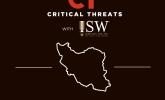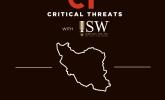November 1, 2022 - ISW Press
Iran plans to send more combat drones and new ballistic missile systems to Russia for use in Ukraine, likely further strengthening Russia’s reliance on Iranian-made weapon systems. The Ukrainian Main Military Intelligence Directorate (GUR) reported on November 1 that Iranian officials intend to send a shipment of more than 200 Shahed-136, Mohajer-6, and Arash-2 combat drones to Russia. The GUR reported that Iran will send Russia the drones in a disassembled state and that Russian personnel will assemble them with Russian markings. CNN reported on November 1 that unnamed officials from a western country that closely monitors Iranian weapons programs stated that Iran plans to send a thousand weapons to Russia by the end of the year, including surface-to-surface short-range ballistic missiles and combat drones. This would be the first confirmed instance of Iran sending Russia advanced precision-guided missiles. Russia likely negotiated the additional Iranian shipment of weapons systems due to the depletion of its stockpile of cruise missile and drone systems over the course of the war in Ukraine, particularly during the Russian campaign against Ukrainian critical infrastructure. The GUR reported that Ukrainian air defenses have shot down more than 300 Shahed-136 drones since Russia starting using them in Ukraine on September 13. Russia will likely continue to use drone attacks and missile strikes against critical infrastructure to try to offset the failures and limitations of its conventional forces on the frontline. Russian dependence on Iranian-made systems, and therefore on Iran, will likely increase.









